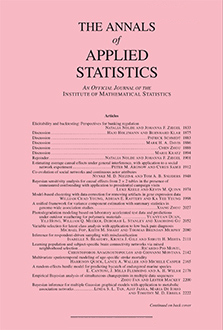Abstract
Rapid developments in geographical information systems (GIS) continue to generate interest in analyzing complex spatial datasets. One area of activity is in creating smoothed disease maps to describe the geographic variation of disease and generate hypotheses for apparent differences in risk. With multiple diseases, a multivariate conditionally autoregressive (MCAR) model is often used to smooth across space while accounting for associations between the diseases. The MCAR, however, imposes complex covariance structures that are difficult to interpret and estimate. This article develops a much simpler alternative approach building upon the techniques of smoothed ANOVA (SANOVA). Instead of simply shrinking effects without any structure, here we use SANOVA to smooth spatial random effects by taking advantage of the spatial structure. We extend SANOVA to cases in which one factor is a spatial lattice, which is smoothed using a CAR model, and a second factor is, for example, type of cancer. Datasets routinely lack enough information to identify the additional structure of MCAR. SANOVA offers a simpler and more intelligible structure than the MCAR while performing as well. We demonstrate our approach with simulation studies designed to compare SANOVA with different design matrices versus MCAR with different priors. Subsequently a cancer-surveillance dataset, describing incidence of 3-cancers in Minnesota’s 87 counties, is analyzed using both approaches, showing the competitiveness of the SANOVA approach.
Citation
Yufen Zhang. James S. Hodges. Sudipto Banerjee. "Smoothed ANOVA with spatial effects as a competitor to MCAR in multivariate spatial smoothing." Ann. Appl. Stat. 3 (4) 1805 - 1830, December 2009. https://doi.org/10.1214/09-AOAS267
Information





